By Jeffrey A. Rendall, Photos By Jeffrey A. Rendall
|
|
KEEZLETOWN, VA – There’s something about fulfilling a lifelong dream that adds a special quality to finishing a project, once that ‘vision’ turns into reality.
In Virginia, we’re fortunate to have many golf clubs that started out as the inspiration of their individual owners – a ‘dream’ -- only to blossom into some of the region’s finest and most unique golf facilities. There’s Virginia National in Bluemont, the vision and hard work of Cliff Boyd. There’s Mattaponi Springs Golf Club at Penola Station, the inspired venture of Jim Oliff. And then there’s Packsaddle Ridge, in Keezletown (in the central Shenandoah Valley), the establishment of a legacy for its founder in a very similar way.
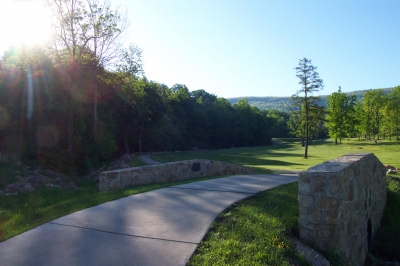 |
| A stone bridge fords a stream on Packsaddle Ridge's 1st hole. You'll see lots of rock throughout the course -- most of it put to good use! |
Packsaddle Ridge is the inspiration of Bruce Forbes, a real estate developer and golf enthusiast. The golf course opened in August of 2002, and this product of love and devotion has been pleasing neighborhood and visiting players ever since. Packsaddle’s layout was designed by veteran architect Russell Breeden, with Forbes’ son Jeff providing much input and taking care of the day-to-day construction operations. The Forbes’ family owned company actually built the course, adding yet another bit of ‘magic’ to the pristine site.
It’s a good thing they were patient, because there were a lot of building days in the process. The project began in mid-October of 1998 – and took nearly four years to complete (about double the time it usually takes to finish a golf course). That’s a lot of hands-on time to make sure every detail’s attended to. But like the aforementioned golf projects, Packsaddle Ridge wasn’t meant to be built overnight. For the fulfillment of a legacy, it takes much longer.
Jeff Forbes, Bruce’s son and co-designer of Packsaddle’s golf course, says there were three reasons why they undertook such a difficult endeavor: “First, my Dad built Packsaddle Ridge just to see if he could. Second, he wanted to leave behind a golf course that would be his legacy – a good quality course that would be around long after he’d gone. Third, at the time it was built, there was public demand for a golf course in this area, because there weren’t that many places to play (he noted that from the time they started construction until opening day, 27 other golf holes were built excluding Packsaddle).”
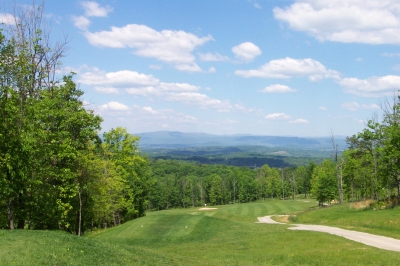 |
| Looking from the tee box on the par five 16th hole. It's a sharp dogleg left, and many spectacular views to your center. |
Forbes, 37, noted that his Dad really enjoyed golf for about twenty years, but only plays occasionally now. The younger Forbes has been playing since he was six, and we speculate he gets a good amount of enjoyment just staying close to home, to play and maintain the course that is his Dad’s legacy, and that he helped create.
Granted, building a golf course isn’t something you just decide to do, then rent a bulldozer and start plowing. Forbes said they purchased the 486-acre Packsaddle Ridge Farm at public auction in three different parcels on April 21, 1998, and away they went. An additional eighty acres, contiguous to Packsaddle Ridge Farm was bought at auction in March of 2001 – the supplemental land being necessary to put in a private mile-and-a-quarter entrance road to the clubhouse.
Urbanites expecting a golf course right off the Interstate will be a bit shocked by going to Packsaddle Ridge, as it’s a series of turns and country roads to get there – and that mile-and-a-quarter road is just the final leg of the journey. Follow the directions closely and you’ll find what you’re looking for, and Packsaddle’s scenery is without question worth the extra time – one of the purest sites in all the Mid-Atlantic.
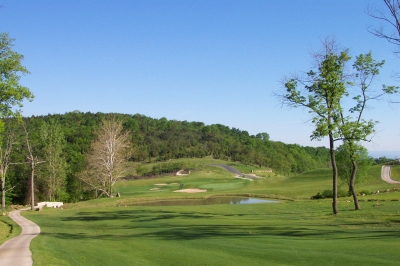 |
| You've got choices on the par five 2nd hole. You can lay-up short of the pond, or try and go over on your second shot. If you make it, you've got a good shot at an early birdie. |
John Denver, in his song ‘Country Roads,’ talked about how ‘life was old there, older than the trees,’ and that’s the type of feeling you’ll get – a tangible sense of history. Forbes said there’s an old farmhouse on the second parcel of land they bought which dates to pre-Civil War times. Folks have been around these parts for a long time, it just doesn’t look like it.
There’s also an old mill on property that burned sometime in the 1800’s – which proves that life wasn’t easy back then, either.
Not that building a golf course in the 21st century is a piece of cake, as Forbes explains: “It took us four years to finish the golf course – with the major construction work, the moving of one million tons of rock and three quarter million tons of topsoil from the farm to the fairways -- accomplished by our family owned company. From start to finish, over three hundred people contributed to the success of the project, which is something we’re very proud of.”
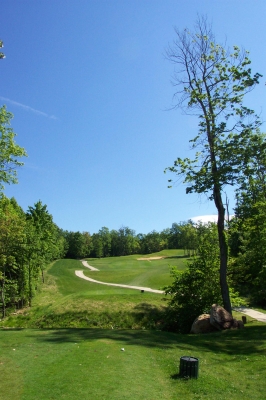 |
| It's practically straight-up on the 185-yard, par three 12th hole. Take at least two extra clubs and climb the mountain. |
Others took note – Golf Digest coined Packsaddle Ridge as the fifth best ‘New Affordable Golf Course in the United States’ in 2003. Not a bad designation for the Forbes company’s first golf construction project – and not a bad legacy for Bruce, either.
Much of that rock that Forbes was talking about shows up on the course – though happily, all the topsoil he also mentioned makes the playing areas more than adequate (in terms of coverage). The rock lines the ponds and streams, a nice accent to the land and the golf course – gives it kind of a rugged quality, much like the rolling nature of the topography.
And you’ll see a lot of variation in the land at Packsaddle Ridge. As you’d expect from a golf course in the hills of the Shenandoah, there aren’t many flat spots on the layout – especially the back nine. Not quite sure of the elevation difference between the tenth tee and the ‘top’ at the thirteenth green, but it’s a good thing there’s a cart there to haul your clubs – and you – up those slopes.
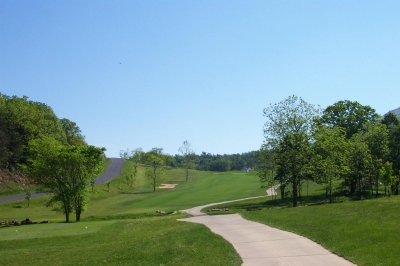 |
| You've just finished a tough sequence of holes, so the par four 9th is a gentle way to conclude your outward nine at Packsaddle Ridge. |
The course is challenging as well, and not just because of the elevation changes. Very much of a shot-makers course, you’ll need to plan shots and placement to set up the next ones – which, when factoring in the severe elevation changes and the windy exposed top of the mountain… well, it’s one of the more difficult tests in the area. Not to mention that nearly every hole is lined by trees, and if you’re a little off-line, you might come face to face with nature in a very unintended way.
The course is softened somewhat by offering five sets of tees, ranging from 4663 yards to just over 7,000. Even from the back sets, there really aren’t that many difficult carries (off the tee), so the trouble is mostly side-to-side, with some streams and ponds appearing here and there to take into account.
Forbes pointed out that many of the area’s courses are pretty wide-open and relatively flat – as was corroborated by conversing with several local players in the parking lot after the round. They said they like to come to Packsaddle for a challenge – and even though their scores might not be what they’d want, it’s the challenge that lures them back.
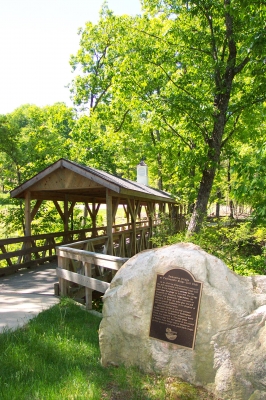 |
| 'Samantha Bridge' crosses the gorge on the par four 14th hole. Take a minute to stop and read the plaque -- it's one of only two covered bridges in Rockingham County. |
Not to mention the beauty. For those favoring the mountain golf experience with all that goes along with it, Packsaddle Ridge is one of the best in Virginia. When you reach the ‘top’ on the back nine, you can see for miles. Don’t keep the group behind you waiting, but don’t forget to take a moment to soak in the views – they’re spectacular.
The playing conditions were also excellent. Forbes says they’ve continued to improve since the course opened three years ago – and they’ll only get better. He also said they’ll keep working on thinning out the brush to the sides of the holes, only increasing the playability for those times when you’re in amongst the trees.
Hole highlights include the third hole, a 175-yard par three fronted by a rocky stream. Named ‘double trouble,’ this little one-shotter proves that yardage can be deceiving – as there’s very little room to miss in any direction. Short is wet, but the hole’s also well protected by sand and grassy slopes. Not to be messed with.
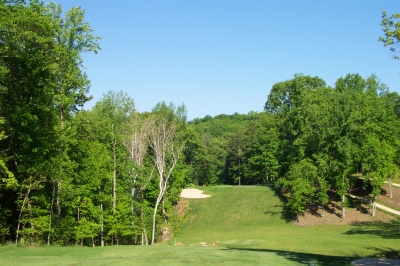 |
| Tucked up there amongst the trees is the 227-yard, par three 7th hole. Forget the ratings, this is probably the toughest hole on the course. |
If you play number eight from the back tees, you won’t forget it. Perched high on a ridge, you’re firing through what looks like a chute of trees, again over a rocky stream. There’s more room in the landing area than it appears, but that knowledge only slightly lessens the intimidation factor. Then you’ve got a mid to long iron second shot to the green. Ouch.
Moving to the back, the fourteenth hole proves the architects’ had some talent for hole variation, designing a 323-yard par four that’s reachable for big boomers if the wind is right. The hole doglegs sharply right, cutting off much of the distance for those inclined to try it. Most notable is a covered bridge with a plaque nearer the green – dedicated to Samantha, Jeff Forbes’ daughter. A nice touch, and setting appropriate as well.
The sixteenth hole is quite a roller-coaster ride of a par five. 519 yards in length, if you can shape your tee shot right to left, you might have a chance to go at the green in two. That being said, you’re probably facing a downhill lie – and you’ve got to fly another pond to get there. Nothing comes easy here, and don’t mark this one down as a certain birdie, either.
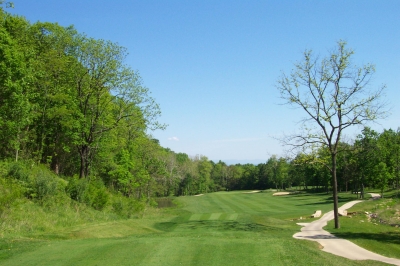 |
| Subtle and unassuming, the par four 10th hole still requires a good drive and approach shot to make a par. |
As a closing note, Forbes says walking is an option to players at Packsaddle Ridge, though you’d have to be in tip-top shape on the back nine to make it work.
The nature of the ground, the views, the golf course – you can see why Golf Digest thought highly enough of Bruce Forbes’ legacy project to honor it in the magazine. Needless to say, Packsaddle Ridge is worth the modest fees they charge. Even if you have a difficult day in the golf sense, the overall experience is rewarding in itself.
Not a bad legacy to leave, all and all.
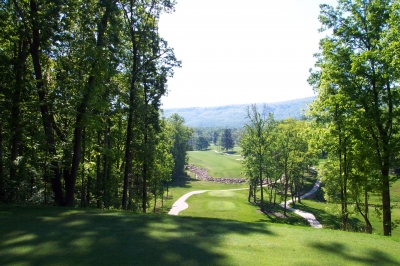 |
| It's probably not wise to try that faded drive from the tee of the long par four 8th hole. It's a ways out there, but there is plenty of space once you get to the landing area. |
Where We Stayed
We visited Packsaddle Ridge the same weekend as the Vista Links, which is farther south in the Shenandoah Valley. Both are easily accessible in one golf trip, however, and we stayed in Lexington, about an hour and twenty minutes from Packsaddle.
In Lexington, we chose the new Sleep Inn & Suites (By Choice Hotels). We’re always looking for affordable accommodations that are a step above your basic motel, and also convenient to the Interstate and local restaurants and attractions – the Sleep Inn was a perfect choice.
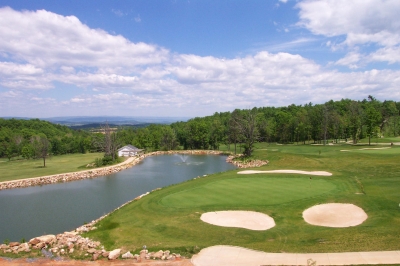 |
| Looking down from clubhouse-level at the 18th green. Not much to complain about when you've got all this to look at. |
The fact it’s a new property never hurts, and add to it the convenience of being able to get a suite when traveling with the kids – that made it a done deal.
Once there, we discovered several conveniences that have become essentials on our travels, such as an indoor pool and spa, a fitness room, laundry facilities and a complimentary continental breakfast, amongst others.
The Lexington Sleep Inn also offers whirlpool suites, a complimentary USA Today for the latest news; iron & ironing board, coffee-makers and hairdryers in all rooms; free local calls and a Board Room to seat 16 – perfect for that before golf meeting for your group.
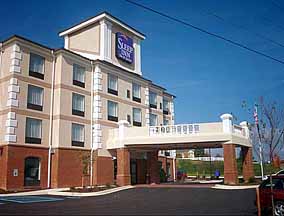 |
| The Sleep Inn & Suites, Lexington |
Finally, it was just up the road from downtown historic Lexington, which contains all the touring possibilities you’ll desire, including the Virginia Military Institute and Washington and Lee University.
The Sleep Inn Lexington is located at 95 Maury River Road, Junction of I-64 and Route 11 in Lexington, with the zip code 24450. Telephone: (540) 463-6000; FAX: (540) 463-6002. Reservations: (800) 4CHOICE. http://www.choicehotels.com/.
Details:
Packsaddle Ridge Golf Club
3067 Packsaddle Trail
Phone: (540) 269-8188
Website: http://www.packsaddle.net/
Course Designers: Russell Breeden and Jeff Forbes
Head Golf Professional: George Dodson
Tees/Yardage/Slope/Rating
Black 7024 139/74.2
Blue 6398 131/70.7
White 5929 128/68.2 (W) 133/74.0
Gold 5470 118/65.7 (W) 126/71.5
Red 4663 116/66.8
Rates:
Weekend $30 green fees, $14 cart = $44
Discount rates available for twilight, seniors, juniors and college students.
| Related Links | Comments on this article? | |
|
Maryland National Golf Club Hollow Creek Golf Club Rocky Gap Resort PB Dye Golf Club in Ijamsville Whiskey Creek Golf Club |
E-mail Jeff Rendall, Editor: jrendall@golftheunitedstates.com |













